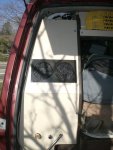eccotemp and propane
The Eccotemp L5 does in fact work with a small 1 lb propane bottle. It needs a small adapter ~$10 but everything hooks up nicely. We have had many showers on it so far, and it is really nice. Not sure how many showers per 1lb bottle, but I heard about 2 hrs of water flow. (I have a larger stock propane tank that will go under the van and hook to the system at some point, but until then, the little 1lb bottle is still going strong, and we keep a spare in the van for when it runs out. I do look forward to not having to recycle/throw out those little bottles, eventually.
The whole thing is quite compact, so long as you can deal with the ventilation of the eccotemp unit, it will fit in a small cabinet, including the propane bottle, pump, hoses, etc. (in the second pic, looking in the cabinet door, the eccotemp on the right and small propane bottle in the back just to the left of the eccotemp). We have ours in the back cabinet of our Vanagon Westfalia, and there is room for several other things in there, and it is not a large cabinet.
Because I have a tire swing away in the back that holds two 5 gallon jerry cans of water, we just pull out the supply line (on the left in first picture), which has about 4 feet of hose (most of the braided hose in the third and last pics is the supply hose, pushed back through the cabinet hole when not using it), and put it in the jerry can. Then pull the marine knob and it turns on two AV fans (in the black housing in the pics)- one fan in one fan out- and powers the pump to pressurize the system to 35psi. The showerhead (tucked above the cabinet for storage in the first picture) has an on/off switch built into it and the pump has a built in power switch based on pressure, so once pressurized, the pump only runs when you have the showerhead switch on, and water flows. The pump has a (very) small pressure tank built in, so there is no pulsing. When water flows, the propane unit turns on and heats it, like immediately. The two knobs on the eccotemp control flow rate and temp. we got it set how we like it and just leave it there, that way, we don't have to open the cabinet. Just pull the knob, the fans turn on, the system pressurizes itself, and you are ready to turn on the showerhead.
I actually like leaving the showerhead unattached to the vehicle, so one handed showering makes you more likely to shut off the water for full lathering, etc. The showerhead will hook onto the tire swing away while lathering. Can get two showers from one 5gallon jerry can easily that way. Pulled very cold water from a high altitude mountain river outside Telluride, into the jerry can, and still the heater got it up to temp no problem. Of course, a particle filter on the end of the supply line helps, plus an inline filter before the pump keeps everything running smoothly.
Power draw is minimal, and no starting the van. A different option from the heat exchanger approach.
-macjack







